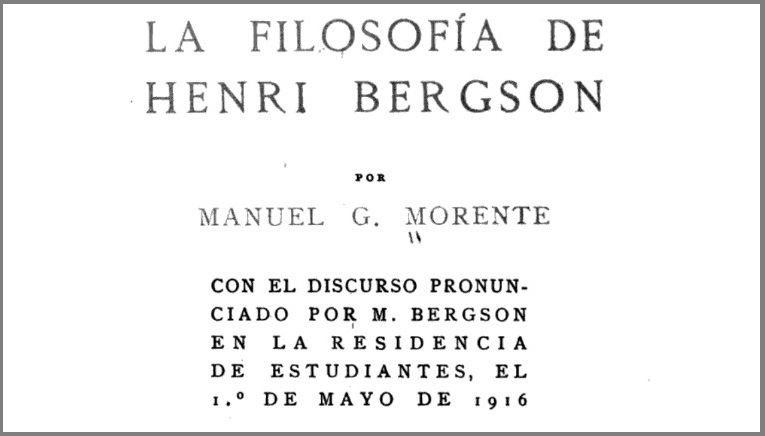- HumanitiesPhilosophy
- 17 de January de 2025
- No Comment
- 7 minutes read
La Filosofía de Henri Bergson, by Manuel García Morente

Forgotten Little Books of Philosophy (5)
La Filosofía de Henri Bergson, by Manuel García Morente


Around the year 1900, Bergson was dismissively described as a metaphysician. The reigning positivism of the time relentlessly persecuted every authentic effort to engage in genuine thought, burying under ridicule and disdain the most venerable terms of the ancient and eternal philosophy. Metaphysics was regarded as the occupation of idle dreamers, a not-always-innocent way to squander time with studied diligence”. This is how Manuel García Morente began the obituary he dedicated to Henri Bergson upon the latter’s death in 1941. García Morente was well-acquainted with the French thinker, having devoted a series of lectures to his work in 1916. That same year, Bergson visited Madrid and delivered a speech in Spanish stating, among other things, that “the unity of philosophy will no longer be that of a finished entity, like a metaphysical system; it will be the unity of continuity, of an open curve that each thinker will extend from the point at which others left it”.
During those intense years, Einstein had brought curves and complex interrelations into vogue. Positivism’s dominance had already waned, and with it—and even slightly earlier—so had the grand metaphysical systems. Ortega y Gasset had set them aside to illuminate his notion of vital reason, while Eugenio d’Ors, who had met Bergson as a young man in Paris, did not stray far from him in developing his dialogical philosophy.
What was García Morente doing meanwhile? In 1906, the Junta para Ampliación de Estudios sent him to Marburg, where he immersed himself in Neo-Kantianism under Cassirer, Cohen, and Natorp. In 1912, he won the Chair of Ethics at the University of Madrid and presented his doctoral thesis, Kant’s Aesthetics. By 1914, he had translated Critique of Judgement; in 1917, he published an extensive monograph on Kant; in 1918, he translated Critique of Practical Reason; and in 1921, Groundwork of the Metaphysics of Morals. During the 1920s, he tirelessly translated for Revista de Occidente. Within Ortega’s circle, Morente, José Gaos, and later Julián Marías aimed to bring Spanish philosophy up to date by translating essential works. During this decade, Morente worked with Spengler, Rickert, Simmel, Scheler, and Hartmann. Alongside Gaos, he translated Husserl’s Logical Investigations (1929) and Brentano‘s The Origin of Moral Knowledge. It would be impossible to claim that García Morente was not wholly dedicated to his intellectual pursuits.
García Morente’s La filosofia de Bergson, a transcription of the three lectures he delivered at the Residencia de Estudiantes in 1916, was first published by the Residencia in 1917. Two subsequent editions followed: Austral’s in 1972 and Encuentro’s in 2010, the latter now digitised by Spain’s National Library. García Morente’s obituary for Bergson accompanied the 1972 edition. In describing Bergson’s fluid (or curved) system, Morente employs aphoristic statements, subtly embedded within the text: “Our knowledge of ourselves can only be intuitive” (1972); “In instinct, knowledge manifests as action”; “Instinct is the unconscious intuition of itself”. Bergson’s anti-positivism must have profoundly impacted many Spanish writers, with Unamuno and Antonio Machado at the forefront. As Bergson writes: “When intellectual analysis is directed towards the inner life of the spirit, it replaces the active spiritual soul with a materialised and false one, and what it analyses and dissects is the immobile trace left by movement”.
Conclusions: “If, through a special effort of tension, we could make intelligence and instinct coincide at a single point, we would achieve intuition”. “The illusion of determinism lies, ultimately, in imagining the spirit as if it were matter and applying the laws of matter to it”. Finally: “To define is to enclose a reality within a concept, to solidify the fluid and immobilise movement”.
Figures such as María Zambrano, Xavier Zubiri, García Morente himself, and Ramiro de Maeztu, each from their own unique and personal positions, would engage deeply with these ideas throughout the 1930s.
Source: educational EVIDENCE
Rights: Creative Commons

